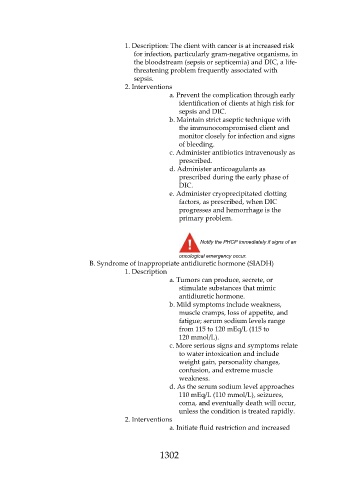Page 1302 - Saunders Comprehensive Review For NCLEX-RN
P. 1302
1. Description: The client with cancer is at increased risk
for infection, particularly gram-negative organisms, in
the bloodstream (sepsis or septicemia) and DIC, a life-
threatening problem frequently associated with
sepsis.
2. Interventions
a. Prevent the complication through early
identification of clients at high risk for
sepsis and DIC.
b. Maintain strict aseptic technique with
the immunocompromised client and
monitor closely for infection and signs
of bleeding.
c. Administer antibiotics intravenously as
prescribed.
d. Administer anticoagulants as
prescribed during the early phase of
DIC.
e. Administer cryoprecipitated clotting
factors, as prescribed, when DIC
progresses and hemorrhage is the
primary problem.
Notify the PHCP immediately if signs of an
oncological emergency occur.
B. Syndrome of inappropriate antidiuretic hormone (SIADH)
1. Description
a. Tumors can produce, secrete, or
stimulate substances that mimic
antidiuretic hormone.
b. Mild symptoms include weakness,
muscle cramps, loss of appetite, and
fatigue; serum sodium levels range
from 115 to 120 mEq/L (115 to
120 mmol/L).
c. More serious signs and symptoms relate
to water intoxication and include
weight gain, personality changes,
confusion, and extreme muscle
weakness.
d. As the serum sodium level approaches
110 mEq/L (110 mmol/L), seizures,
coma, and eventually death will occur,
unless the condition is treated rapidly.
2. Interventions
a. Initiate fluid restriction and increased
1302

